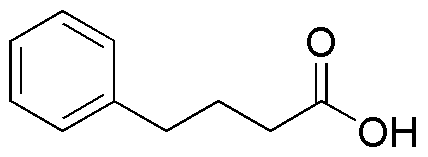4-Phenylbutyric acid is widely utilized in research focused on:
- Pharmaceutical Development: This compound is explored for its potential in treating various neurological disorders, such as Huntington's disease, due to its ability to enhance protein folding and reduce toxicity in cells.
- Cell Culture Applications: It serves as a chemical chaperone in cell culture, helping to improve the yield and functionality of recombinant proteins, which is essential for biopharmaceutical production.
- Research on Metabolic Disorders: The compound is being studied for its effects on metabolic pathways, particularly in conditions like obesity and diabetes, where it may help regulate lipid metabolism.
- Cosmetic Formulations: In the cosmetic industry, it is used for its moisturizing properties and potential anti-aging effects, making it a valuable ingredient in skincare products.
- Food Industry Applications: It has been investigated as a food additive for its flavor-enhancing properties, providing a unique taste profile in various food products.
General Information
Properties
Safety and Regulations
Applications
4-Phenylbutyric acid is widely utilized in research focused on:
- Pharmaceutical Development: This compound is explored for its potential in treating various neurological disorders, such as Huntington's disease, due to its ability to enhance protein folding and reduce toxicity in cells.
- Cell Culture Applications: It serves as a chemical chaperone in cell culture, helping to improve the yield and functionality of recombinant proteins, which is essential for biopharmaceutical production.
- Research on Metabolic Disorders: The compound is being studied for its effects on metabolic pathways, particularly in conditions like obesity and diabetes, where it may help regulate lipid metabolism.
- Cosmetic Formulations: In the cosmetic industry, it is used for its moisturizing properties and potential anti-aging effects, making it a valuable ingredient in skincare products.
- Food Industry Applications: It has been investigated as a food additive for its flavor-enhancing properties, providing a unique taste profile in various food products.
Documents
Safety Data Sheets (SDS)
The SDS provides comprehensive safety information on handling, storage, and disposal of the product.
Product Specification (PS)
The PS provides a comprehensive breakdown of the product’s properties, including chemical composition, physical state, purity, and storage requirements. It also details acceptable quality ranges and the product's intended applications.
Certificates of Analysis (COA)
Search for Certificates of Analysis (COA) by entering the products Lot Number. Lot and Batch Numbers can be found on a product’s label following the words ‘Lot’ or ‘Batch’.
Número de catálogo
Número de lote/lote
Certificates Of Origin (COO)
This COO confirms the country where the product was manufactured, and also details the materials and components used in it and whether it is derived from natural, synthetic, or other specific sources. This certificate may be required for customs, trade, and regulatory compliance.
Número de catálogo
Número de lote/lote
Safety Data Sheets (SDS)
The SDS provides comprehensive safety information on handling, storage, and disposal of the product.
DownloadProduct Specification (PS)
The PS provides a comprehensive breakdown of the product’s properties, including chemical composition, physical state, purity, and storage requirements. It also details acceptable quality ranges and the product's intended applications.
DownloadCertificates of Analysis (COA)
Search for Certificates of Analysis (COA) by entering the products Lot Number. Lot and Batch Numbers can be found on a product’s label following the words ‘Lot’ or ‘Batch’.
Número de catálogo
Número de lote/lote
Certificates Of Origin (COO)
This COO confirms the country where the product was manufactured, and also details the materials and components used in it and whether it is derived from natural, synthetic, or other specific sources. This certificate may be required for customs, trade, and regulatory compliance.

